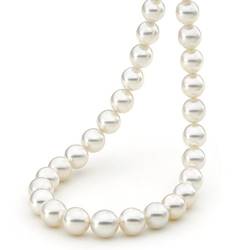The affordable pearl era
 5.0 k views | By Carla Caruso • Journalist
5.0 k views | By Carla Caruso • Journalist
Pearls are still proving popular with jewellery consumers thanks to affordable ranges, innovative design and a greater variety enabling broader industry reach.
The human race has had a fascination with pearls for centuries. In ancient times, Egyptian queen Cleopatra was said to have dissolved a pearl in wine and drank it to prove her love to Roman general Mark Antony – a scene now famously depicted in a painting that draws thousands to the National Gallery of Victoria each year.
Indeed, pearls have long been seen as extraordinarily precious. Back in 1917, Pierre Cartier bought a Fifth Avenue mansion – now Cartier’s New York store – in exchange for one matched, double strand of natural pearls, then worth $US1 million. It seems that as far as the Americans were concerned, pearls have even been worthy of handing over in exchange for prime real estate.
But, while the lustrous organic gem still has a high standing among consumers, innovations and evolution in supply have certainly opened up the market. As Erica Madsen, founder of Sydney-based Ikecho Pearls, points out, “Over time, advances in pearl farming technology and the mass production of cultured pearls have made pearls more affordable.”
It all started in the early 1900s, when a supply shortage of natural pearls saw the launch of the cultured variety on the market – created in pearl farms, rather than collected in the wild. While the cultured pearls were not accepted immediately, by the 1950s an era of every woman being able to own her own pearl necklace had kicked off. Natural pearls, being so rare, were reduced to a small, exclusive niche.
Couple that with new design innovations, fashion trends and better imitations, and these objects of beauty now come at myriad price points – a fact that has not escaped consumers, who are more enamoured with pearls than ever before.
Design innovation, in particular, is alive and well in the pearl jewellery sector – shoppers only have to look at local labels like Autore to feel inspired. The award-winning Australian South Sea pearl and jewellery design company updates its collections several times a year and showcases its new pieces at trade fairs around the world. A standout addition from the recent BaselWorld watch and jewellery show included its Fer Forgé ring in white gold, featuring white diamonds, rustic diamonds and a beautiful 14mm South Sea pearl, inspired by the wrought-iron gates of Venice.
Chi Huynh, the founder of Californian pearl brand Galatea – which intends to enter the Australian market later this year – is convinced that exciting, contemporary designs are helping to raise the profile of pearl jewellery around the world. “Pearls have been popular throughout the ages except for brief periods of time when they were thought to be too conservative,” he say. “With the advent of great design, pearl jewellery has never been so innovative.”
And Huynh certainly knows a thing or two about innovation. Hailed as a revolutionary figure in the jewellery industry, he is credited with the biggest innovation in the pearl market in the past 10 years after becoming the first person in the world to culture a pearl using a gemstone (see Jeweller news, June 2011). Once cultured, Galatea carves its pearls to let the gemstone shine through, creating a unique look.
The brand’s Sculpted Tahitian pearls range, perfected after years of experimentation, are carved by hand with a variety of signature motifs. “When carved, their deep nacre and colour makes the polished carvings gleam in a way that is very beautiful,” Huynh says.
Galatea also has a more affordable interchangeable Queen Bead collection, the first range to be set in sterling silver, which offers more than 135 unique pearl beads. “It took us many months to build the machinery we needed to core the pearl properly, so it didn’t break,” Huynh tells Jeweller. “Woman can buy one pearl at a time to create a necklace, bracelet or a set of earrings and this makes them tremendously affordable.” The manufacturer’s suggested retail price is $US112.50 for a black South Sea Queen Bead and $US45 for a peach or white freshwater pearl.
Galatea is one of many pearl brands branching out into more affordable lines as consumers tighten their belts in the face of tougher economic conditions both in Australia and overseas.

Kailis Jewellery
James Paspaley, executive director of Paspaley – the largest pearling company in Australia – told the Territory Quarterly he believes it has been the single most difficult period of time the pearling industry has endured in the modern era, with many retailers reportedly down 30 to 40 per cent during the time of the Global Financial Crisis.
Anne Pesic of Willies Creek Pearls, which retails pearl jewellery and runs its own pearl farms in Western Australia, paints a similar picture: “International demand was adversely affected due to the GFC, many farms reduced seeding in response to falling sales and now have been working hard to streamline and fine tune their businesses to ensure that they are in a good position to take advantage when the turnaround comes.” For Australian pearl farmers, it hasn’t helped that America was one of the worst affected countries, as it was traditionally the largest market for Australian South Sea pearls according to Pesic.
To combat this crash in demand in some territories, many jewellery companies have sought to make South Sea pearls more accessible by pairing them with less expensive materials. Pesic explains, “The fact that more pearl brands are offering more affordable pearl lines is a reflection of both the economic climate and that now, more than ever, it has become a very fashionable trend to wear pearls casually and not just for evenings or special occasions.”
For example, Australian family-owned pearl company Kailis, which has been in the business for more than three decades, launched a line of silver jewellery featuring Australian South Sea pearls in 2009. South Sea pearls are the rarest and finest cultured pearls in the world, and while Kailis’s usual collection pieces range from $1,000 to $24,900, its silver items cost just $200 to $1,290.
Western Australia’s Allure South Sea Pearls is about to do the same. “We are currently releasing a silver and South Sea pearl range as part of our push to target entry-level pearl purchases,” explains company representative David Boulton.
Silver is also key for Sydney jewellery supplier Missie von Lubbe, which uses South Sea pearls from Australia and freshwater pearls from Asia in its designs.
Missie von Lubbe is not alone in using more affordable varieties of pearls from overseas – a practice which is also helping to feed the thirst for the fashion look without hurting consumers’ pockets so much, particularly when it comes to colour.
Madsen says Ikecho uses Tahitian, Akoya, Mabé and Chinese freshwater pearls, as well as South Sea pearls. “Coloured pearls are definitely becoming more admired, namely [in] the freshwater pearls. Because they are so affordable and can be dyed so many different colours, including purple, blue, gold, green and grey. Presently, the grey and black tones are extremely popular coming into winter,” she reveals.
Freshwater pearls, tending to come from mussels, aren’t as highly valued as pearls from the sea. A decade ago they were known for their small sizes and lopsided shapes, but recent improvements in their cultivation and processing techniques have made them a much more enticing prospect for designers and consumers alike. It wasn’t until the 1990s, when China surprised the market with freshwater pearls that were of much higher quality, that perceptions began to change.
So could cheaper types of pearls have a negative impact on the South Sea pearl market? Ronnie Bauer, the Gemmological Association of Australia’s CIBJO representative and owner of Klepner’s Fine Antique Jewellers in Melbourne, thinks not. “It’s like saying, ‘Will the Ford market overrun the Ferrari market?’ It never will. People will always want Ferraris.”
However, he warns, “Where the danger comes in – because the freshwater pearls are getting better and better – is if the retailer tries to sell them as a South Sea pearl, when they’re actually freshwater pearls.”
Aside from different pearl types, Bauer says jewellers are also getting creative in their use of lower-quality pearls to make their pieces more affordable. Like diamonds, pearls have their own system of grading, based on their lustre, colour, shape, surface and size. “For example, as a comparison, when you get pavé-set diamond jewellery, it’s all clusters of diamonds. Now, nine times out of 10 they won’t use perfect diamonds for that, but it gives the same ‘blingy’ look,” Bauer explains. “It’s the same with pearls. You can use lots of pearls and all sorts of qualities of pearls and mix them with other media and they can look quite good and become affordable.”

Allure South Sea Pearls
Indeed, budget-savvy materials are also being used to extend the pearl look and make it more affordable. Madsen says Ikecho’s sterling silver range is its largest and most popular. “By using materials such as sterling silver, stainless steel, neoprene [a synthetic rubber], cubic zirconia, glass beads and other gemstones, like smoky quartz and peridot, we are able to make innovative yet inexpensive designs for the consumer,” she says.
Improved accessibility isn’t the only driver of pearls’ increasing popularity either – celebrity endorsement and catwalk trends are widely believed to have helped whet the consumer appetite for pearls too. Gabby Garewal, who runs fashion jewellery label Punjaban Diva, which uses freshwater pearls, says: “I have seen pearls being incorporated in designer dresses, like the Chanel winter 2010 dress worn by Keira Knightley [at the London Film Festival].”
Similarly, Eryn Behan, managing director of Melbourne trend forecasting agency Ginger Trend Consulting, adds, “The late Elizabeth Taylor was frequently spotted wearing pearls – the death of a major film star can play a significant role in short-term trends.”
Short-term trends are all well and good, but it looks like consumers’ fascination with this lustrous gem is far more deep-rooted than that. And, with so many affordable options exploding onto the market, retailers would do well to become devoted followers too.
know your pearls
• Precious pearls come from oysters, but most molluscs can produce them — for example, freshwater pearls tend to come from mussels, though they’re not as highly regarded as those from the sea.
• Like diamonds, pearls have their own system of grading, based on their lustre, colour, shape, surface and size.
• Natural pearls are created when a foreign body, such as a grain of sand or a parasite, finds its way into a mollusc. The mollusc then reacts by coating the irritant with layer upon layer of nacre, which gives the gem its unique, iridescent quality.
• A cultured pearl is created when a human places a bead into the gonad of the mollusc and that mollusc produces a pearl, because it is trained to deal with the irritation. The Australian cultured pearling industry now grosses more than $200 million per year. It’s carefully managed with an annual quota of 600,000 ‘wild’ collected shells allocated between the 19 pearl farming licences here –18 of which are located in Western Australia.
• The majority of cultured pearls sold in Australia are the Akoya type and they come from Japan. According to the GAA’s CIBJO representative Ronnie Bauer, this is because “they’re much cheaper than the South Sea ones”. Australian South Sea pearls are considered the most prestigious and valuable in the world and are largely sold overseas.
• Akoya pearls usually range from about 5mm to 8mm in size and the South Sea pearl from about 10mm upwards. Bauer says the culturing process usually takes a lengthier three years for the South Sea pearls, while it can be just under a year for the Akoya variety (which partly explains why it is cheaper).
• The term “imitation pearl” is used to define anything that looks like a pearl. Artificial pearls are usually shell-based or made of plastic.
More reading:
US pearl brand eyes Australia
Changes to pearl nomenclature?
Posted July 01, 2011